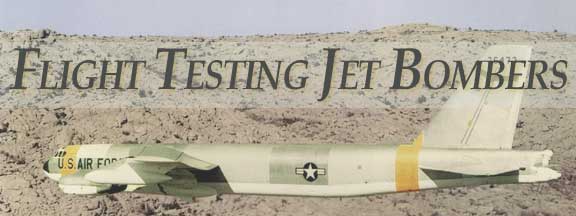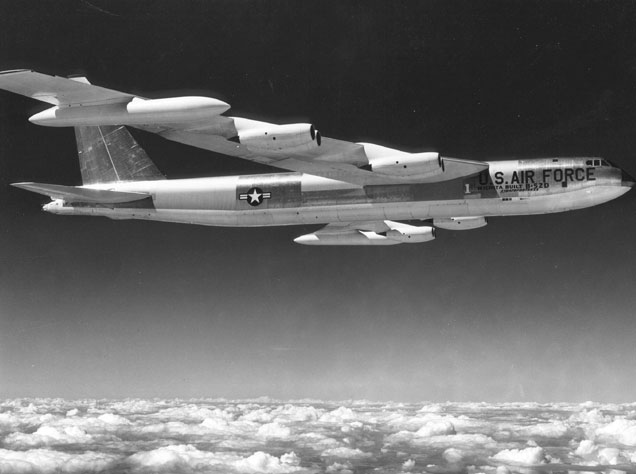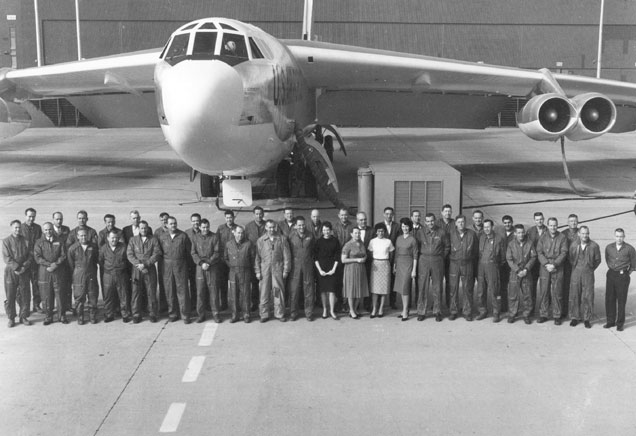

Flight Testing Jet Bombers. A Boeing Wichita Story
After returning from Test Pilot’s school at Edwards in 1955, I got to go to Seattle to fly on the B-52. Boeing-Seattle was deep into B-52 testing. They had about eight test airplanes and all the flying they could handle, so some of the Wichita flight crews got to go to Seattle and help. My turn came in August, which is a good time to be in Seattle weather wise. The wife and kiddies (two girls at the time) went also. We enjoyed the scenery and the weather, but not living out of suitcases.
There was a lot of flying, but because of morning fog most of it occurred at night. The typical flight took off at 2pm and landed at 11pm. I found the B-52 very uncomfortable. We sat in a hard back seat with a parachute and life vest strapped on us. The first 2 hours were miserable. After that you got numb, and it didn’t bother as much. The air conditioning wasn’t good. If the pilots were comfortable during day light hours the navigator and bombardier (both of whom sat down stairs) were too cold. They had no warming sunlight. At night the pilots began to get cold, but they couldn’t turn the heat up enough because the people down stairs got too warm. They had the additional heat of the radar and the bomb-nav equipment. It seemed to end up as a compromise with every one uncomfortable. The tail gunner sat all by himself in the tail with his own air conditioning system. I guess he did OK, but it was no place for a man with normal social inclinations or with claustrophobia.
I can’t say I really enjoyed flying the B-52, but it did have good performance. It was temporarily ahead of the fighters of the time. We used to enjoy out running the fighters the Air Defense Command sent up for practice intercepts. The B-52 could do it because of its high speed and high altitude capability. The typical intercept fighter (F-89 or F-86D) would have to return home for lack of fuel before a successful intercept was completed.
Although the performance of the B-52 was good, the handling qualities left a lot to be desired. I’m not sure what considerations dictated the design of the control system, but I do know it caused problems. The airplane had a 10% cord elevator and rudder. That is the elevator and rudder were smaller and less powerful than those on most airplanes. Most airplanes have 25% cord elevators and rudders. The smaller elevator meant the airplane could not be controlled in pitch with the elevator alone under all flight conditions. The stabilizer trim had to be used more than on other airplanes. Not all pilots remembered to do this. The narrow cord rudder meant the airplane had to have a crosswind landing gear system, because the rudder was not powerful enough to take the airplane out of crab just prior to touchdown on a crosswind landing. The elevator and rudder were aerodynamic rather than hydraulic powered. This is probably why the smaller elevator and rudder were necessary.
There were some big pitch changes when operating the speed brakes. The airplane pitched up considerably when the speed brakes were raised. This had to be anticipated. The pilot could not hold the desired attitude with the elevators alone when the speed brakes were raised or lowered. He had to use a considerable amount of stabilizer trim. The same was true when the flaps were extended or retracted. The airplane pitched over a lot during the last part of flap retraction.
At the end of the six weeks temporary duty at Seattle and on the way home to Wichita, I stopped by Moses Lake in Eastern Washington and flew with the Air Force to get a check ride.
It was a simple affair with 3 landings. The B-52 was a little tricky to learn to land because it tended to roll back and forth during the approach. When first tried, it was difficult to damp this rolling out, and in fact, the pilot sometimes accentuated the rolling and made it worse. After 10 or 15 landings however, the pilot subconsciously damped out the rolling and concentrated on other things. There was also the necessity of learning how to use the crosswind landing gear. The landing gear was moved by a control in the cockpit to align it with the runway if the airplane was crabbed off the centerline. A card was provided in the cockpit giving the number of degrees the gear should be turned depending on the wind velocity and direction given by the tower. Of course the gear had to be turned in the right direction, left or right. More about that later.
The check ride didn’t mean much for me, as I didn’t get to fly as pilot on the B-52 for sometime. After going back to Wichita I resumed flying the B-47.

First B52 Built at Boeing Wichita

B52 Wichita Test Crews and Supporting Personnel
Eventually, in 1956, I think, B-52 production was moved to Wichita. Some of the test airplanes were moved to Wichita. One of the test airplanes was destroyed and three crewmembers killed on a test flight. A fuel vent test was scheduled. The test plan was to climb to a high altitude, 40,000 ft. or above, extend the speed brakes and push over as rapidly as possible into a dive. The object was to see if the vent system could handle the escaping fuel vapors well enough to prevent over pressure and damage to the fuel tanks. Several such descents were planned.
On the first one or two pushovers a couple of the alternators kicked off. On the next pushover all four alternators kicked off causing loss of all electrical power except the battery. Prior to the pushover the pilot had used a lot of nose down trim anticipating a nose up pitching moment when he extended the speed brakes. On the fatal pushover when all of the alternators failed, two things happened, both bad. The speed brakes retracted and the electric trim became inoperative. The speed brakes required electric power from the alternators to hold them up. There was no way to manually operate the stabilizer trim.
When the speed brakes fell down the nose of the airplane pitched over further increasing the dive angle. The elevators were not capable of pulling the airplane out of the dive. The lack of speed brakes caused the airspeed to increase rapidly and finally the speed exceeded the structural limit of the airplane and the airplane broke up.
There were four people on board the airplane. The pilot, Ross Patrick, the co-pilot. Chuck Craven, the navigator, John McCort, and the test engineer. Earl Reed. Only Earl Reed survived the accident. Craven ejected but was killed by the debris of the airplane. Patrick’s and McCort’s ejection seats did not work. Reed’s survival was a miracle. When he first tried to eject his seat did not fire. The hatch above him would not leave the airplane. That was the first thing that had to happen in the ejection sequence. Finally the hatch left and the seat fired. For several weeks after the accident Earl was walking around with two black eyes and a swollen face. The air blast outside the airplane had worked him over good.
Following the accident the B-52 fleet was modified so that the spoilers would not fall down if electrical power was lost. I think a holding circuit was wired to the battery. Also a modification was made so the pilot could reach the stabilizer trim wheel and apply manual trim if electrical trim became inoperative.
Other B-52 accidents were caused by the lack of elevator control. The last part of flap retraction. It was impossible to hold altitude during flap retraction without using stabilizer trim. Pilots had to learn this and start trimming nose up early during flap retraction to hold altitude. One pilot did not do this. During flap retraction in the clouds following takeoff he instinctively pulled back on the control column when the airplane pitched over. When the airplane continued to pitch over, he assumed control was lost and ejected. The airplane crashed. Following this accident, a presentation was made to Air Force pilots titled, “No distraction during flap retraction.”
The problem with the elevator trim was that it was not used instinctively because the control force did not heavy up enough to cause the pilot to trim. On most airplanes the trim is used to relieve a force. When the pilot pushes or pulls on the control column and a high force stops him, he trims to relieve the force. The control column on the B-52 could always be pushed or pulled full travel without trimming except in very high speed low level flight. As stated before, in many flight situations not enough happened with full elevator application so the stabilizer trim was needed to get the desired pitch change.
When flying became available on production airplanes at Wichita I decided I should get familiar with the B-52 again. I asked to go on a production flight and Curly Graham agreed to be my instructor pilot. Curly was a nice guy who stuttered occasionally. When he did his adams apple moved up and down. This was fascinating to watch. We all thought he was called Curly because he was bald, but he told us that he had actually had a lot of curly hair when he was a young man, and that is how he got his nickname. We all considered him old at the time - he being close to fifty and we being in our thirties. Looking back his age (47) doesn’t sound old at all.
At the end of the flight with Curly, when we arrived back at the airport, the wind was a brisk 30 kts out of the northwest. It had been about 5 kts out of the south when we took off. Curly suggested that he do the gear alignment on final, as the crosswind crab dictated, while I concentrated on flying the airplane. He said that was the method they had been using. It sounded OK to me. I concentrated on getting a smooth touchdown about 1500 ft. from the end of the runway. It was a good touchdown, but shortly thereafter the airplane started translating to the upwind side of the runway. I thought Curly had deployed the brake chute and it was pulling us around into the wind. I asked him to jettison the chute, but he thought I asked for the chute to be deployed, so he did that. That really cooked our goose, as the chute did pull us around into the wind. I tried banking the airplane to steer it back on to the runway, but it just kept going off and finally settled into the soft ground about 50 yards short of the GCA Shack. I don’t know if the GCA people knew they were in jeopardy. When we stopped we shut down the engines and got out to take a look. There was very little damage to the airplane, but I noticed the landing gear was turned the wrong way. I told Curly that he had turned the gear the wrong way. He stuttered and said, “I I I know know it”.
We got picked up by the “meat wagon” a standard procedure for an accident—injuries or not. We were taken to the dispensary. The tail gunner, Gene Arnold, was forgotten and had to shiny down a rope. A procedure he was to repeat after a later incident.
When we got back to flight test, they separated us to get our statements and then we met in a conference room for a hearing. It was then I learned that Curly had not deployed the brake chute until I had said, “jettison the chute.” This was a surprise. Fortunately Boeing and the Air Force did not fire Curly or me. It was decided that we should be rechecked. Boeing held out for a Boeing Instructor Pilot who turned out to be Ed Hartz from Seattle.
The check ride occurred several weeks later. Curly was in the pilot’s seat for takeoff. Ed Hartz was in the right seat, and I was in the instructor pilot’s seat, behind and between the two pilots. After takeoff and while climbing through 15,000 ft.. Gene Arnold, who was in the tail again, said, “should we be leaving con trails at this altitude?” Hartz said, “hell no”, and told Curly to turn back toward the field. Ed also instructed the navigator downstairs to look into the alternator deck. I don’t know what gave him the clue about that. The navigator, Benny Malone, reported the alternator deck was full of fumes or white smoke. This indicated to Ed that we had a big fuel leak. There were some big fuel lines running through the alternator compartment with connections in that area. This was a most unfortunate combination of fuel and electricity.
As we approached the field, Hartz declared an emergency and told the tower our problem. The tower reported seeing our trailing white smoke. Ed said, “ OK tell us if it starts turning black.” This would indicate the fuel had caught on fire. In that case I guess the plan was to bail out before we blew up. In the meantime I went back and strapped myself in the ECM seat because the instructor pilot’s seat was not an ejection seat. When we were on the landing final, too low to eject, the tower man said, “ I think the smoke is turning black now”.
We landed and took a high speed turn off and braked to a stop. We all departed the airplane as rapidly as possible. In the case of Gene Arnold, this was not very rapid. He had to shinny down the rope again out of the tail turret. I think that was his last flight in the B-52. He decided to give up flying for some safer work. I can’t say that I blame him. His flying experiences hadn’t been too good. I think the Air Force decided that Curly and I had passed our check ride, as I don’t remember having to do anything more about it.
My first B-52 flight test program was a test to determine why the shimmy dampers were breaking on the outrigger wing tip gear. The airplane was equipped with large 3,000 gallon external wing tanks. The plan was to make a series of landings and put one of the wing gear on the ground at higher and higher speeds until the shimmy damper failed. The damper was instrumented, and from the readouts it was hoped the answer would appear. We made innumerable landings with no signs of failure, so out of desperation I decided to load up the gear by rolling the wing down hard after landing. I over did it on the second try and the wing tank dragged on the runway and ruptured.
This caused lots of excitement as the tank started leaking. Fortunately somebody had preplanned and the tank had only water in it. There was no fire danger, but there was the danger of a lateral control problem if the tank leaked real fast. I was thinking this as we rolled down the runway. We were running out of runway if I wanted to abort. I had almost decided to abort and was making motions in that direction when I caught sight of Glenn Botsford, the co-pilot, waving his hands like maybe aborting was not a good idea. I decided he was right so off we went. All the way on downwind I heard people yelling on the radio about that B-52 with a big fuel leak. I kept wondering if we would have a lateral control problem and have to jettison the wing tanks. We didn’t and landed with no problem. It was later found that the shimmy dampers failed randomly under non-repeatable conditions and just had to be beefed up.
